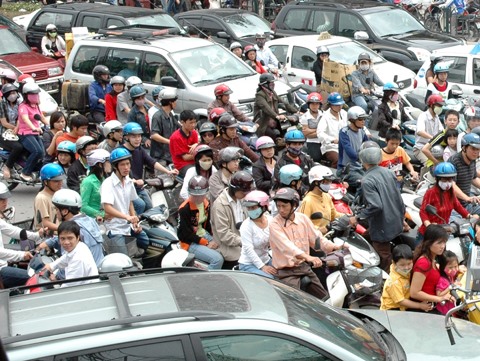 Opinion
Opinion

Professor Nguyễn Văn Thụ, who has involved in Hà Nội’s traffic planning, speaks to Khoa học & Đời sống (Science and Life) newspaper about the city’s draft resolution on phasing out motorcycles from inner districts from 2017 onwards.
 |
Professor Nguyễn Văn Thụ, who has involved in Hà Nội’s traffic planning, speaks to Khoa học & Đời sống (Science and Life) newspaper about the city’s draft resolution on phasing out motorcycles from inner districts from 2017 onwards.
How do you respond to the draft resolution on phasing out motorcycles from the inner districts from 2017-2020 and the vision to 2030?
Many foreign countries have already prohibited motorcycles in their cities. They were successful with their decision as they had very a good public transport system. Whether Hà Nội’s ambitious plan will become reality or not depends on the availability of public transport for the people to use, if not motorbikes will still be their main means of transport.
As a Hà Nội transport planner, do you think the city’s plan can be realised by 2030?
I’m sorry to say, it is very difficult to see. In my opinion, by 2070, Hà Nội will be able to have a complete public transport system, specifically the elevated train system or the underground train system because construction progress in Hà Nội is at snail’s pace.
Just look back at the French colonial time, almost everything was done by hand, but the 70km of railway connecting Sài Gòn with Cần Thơ took only seven years to complete. Now, look at the construction of the Hà Nội elevated train system, despite being much shorter than the Sài Gòn-Cần Thơ railway, it has taken more than a decade.
Apart from sky-rocketing, construction cost why has the construction taken so long?
In my opinion there are two main reasons, the lack of investment budget and leaders’ lack of determination to complete the construction on time.
On the other hand, we all know that in public transport, particularly the elevated train system or the underground system, the return of investment is slow and not as high as investment in other fields.
Don’t you agree that before making investment decisions, Hà Nội authorities must think carefully?
All leaders want to make something new or a breakthrough in their term in office. But I don’t know if they will remain in office for several terms – until 2030. I doubt it. But either way, their objective should be considered a target for the city.
Why have many people objected to the city’s plan to prohibit motorbikes in the inner city?
There are two main reasons.
Firstly, the city’s public transport system is not yet fully developed. For example, some people want visit their home village which is about 4km from Cầu Diễn in Nam Từ Liêm District (west of the city), but the public transport is only available from the Hoàn Kiếm Lake (or the city downtown) to Cầu Diễn. That means they have to use other means of transport to go to their home village. This is a key reason why many people prefer motorbikes.
And second, motorbike is the means of transport for many people and provides others with their livelihood.
Addressing these two issues is the responsibility of Hà Nội’s authorities.
In my opinion, from now till 2030, motorbikes will remain the main means of transport for many people. If the ban is enforced, it will only be on certain main thoroughfares.
Do you think that motorbikes are to be blamed for the city’s traffic congestion and environmental pollution?
I don’t think so. The blame should be placed on the city’s poor infrastructure development. For example, due to a lack of investment funds, a portion of the road running from Ô Chợ Dừa Ward (Đống Đa District) to the Russian Embassy has remained a bottleneck for years.
In my opinion, the city’s population is growing rapidly while road expansion has failed to match this growth. This is the reason traffic congestion is getting worse.
Don’t you think the blame should be put on poor planning?
If 40 or 50 years ago, we had the money to invest in expanding the city, no doubt the investment cost would be much cheaper due to land compensation price at that time being much, much cheaper than nowadays. Nowadays, land compensation price is rocketing and the country’s public debt has already reached its ceiling. Where can we find the money to invest in infrastructure? This remains an open question without an answer yet. — VNS




